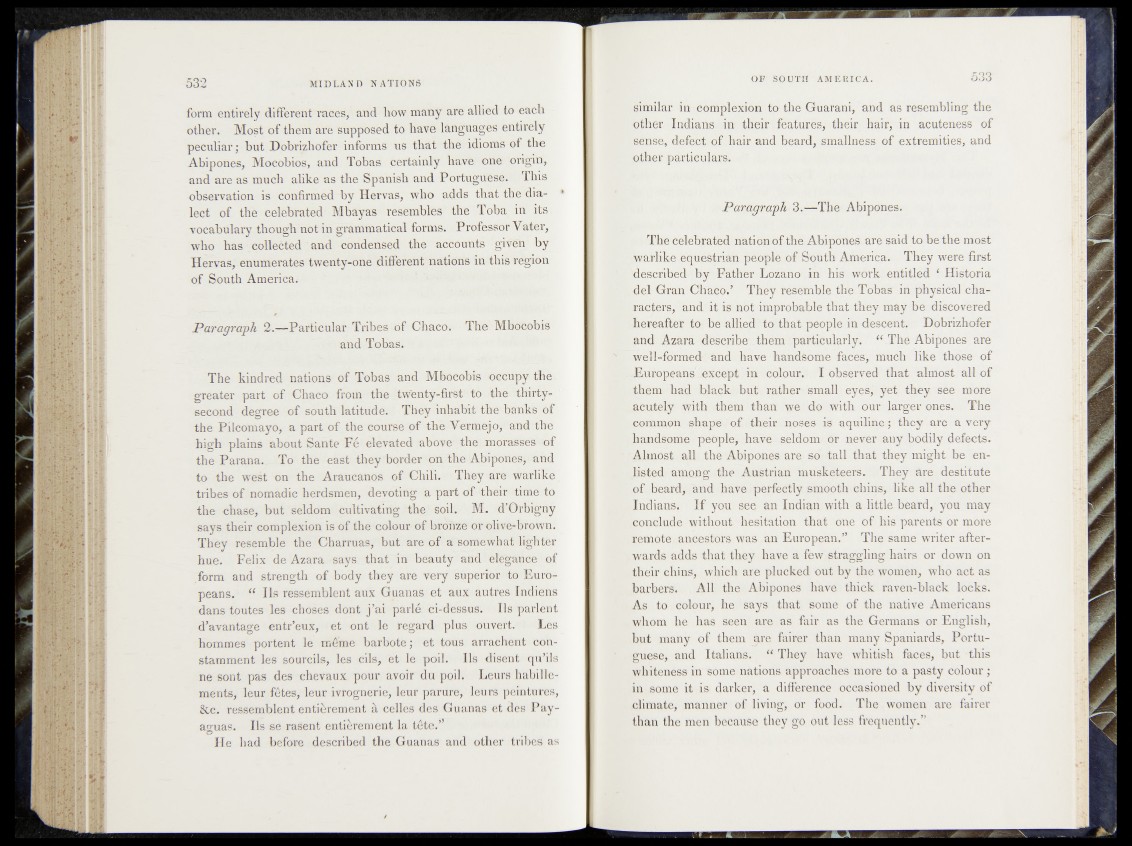
form entirely different races, and how many are allied to each
other. Most of them are supposed to have languages entirely
peculiar; but Dobrizhofer informs us that the idioms of the
Abipones, Mocobios, and Tobas certainly have one Origin,
and are as much alike as the Spanish and Portuguese. This
observation is confirmed by Hervas, who adds that the dialect
of the celebrated Mbayas resembles the Toba in its
vocabulary though not in grammatical forms. Professor Väter,
who has collected and condensed the accounts givëh by
Hervas, enumerates twenty-one different nations in this region
of South America.
Paragraph 2.—Particular Tribes of Chaco. The Mbocobis
and Tobas.
The kindred nations of Tobas and Mbocobis '-occupy thé/
greater part of Chaco from the twenty-first to the thirty-
second degree of south latitude. They inhabit the bjarifefef
the Pilcomayo, a part of the course of the Vermejo,'and the
high plains about Santé Fe elevated above the mdraése&Mof
the Parana.. To the east they'border on the Abiporiesp and
to the west on the Araueanos of Chili. They‘are warlike
tribes of nomadic herdsmen, devoting a part of their time to
the chase, but seldom cultivating the soil. M. d’Orbigny
says their complexion is of the colour of broftze or olive-brown.
They resemble the Charruas, but are of a somewhat lighter
hue. Felix de Azara says that in beauty and élégance of
form and strength of body they are very superior to Europeans.
“ Ils ressemblent aux Guanas et aux autres Indiens
dans toutes les choses dont j ’ai parlé ci-dessus. Ils parlent
d’avantage entr’eux, et ont le regard plus ouvert. Les
hommes portent le môme barbote ; et tous arrachent constamment
les sourcils, les cils, et le poil. Ils disent qu’ils
ne sont pas des chevaux pour avoir du poil. Leurs habillements,
leur fêtes, leur ivrognerie, leur parure, leurs peintures,
&c. ressemblent entièrement à celles des Guanas et des Pay-
açaias. Ils se rasent entièrement la tête.”
He had before described the Guanas and other tribes as
similar in complexion to the Guarani, and as resembling the
other Indians in their features, their hair, in acuteness of
sense, defect of hair and beard, smallness of extremities, and
Other particulars.
Paragraph 3.—The Abipones.
The celebrated nation of the Abipones are said to be the most
warlike equestrian people of South America. They were first
'described by Father Lozano in his work entitled ‘ Ilistoria
del Gran Chaco.’ They resemble the Tobas in physical characters,
and it is not improbable that they may fee discovered
hereafter to be allied to that people in descent, Dobrizhofer
and Azara describe .them particularly. “ The Abipones are
well-formed^-and have handsome iaCiiSy much like those of
iEuropeans^except in colour. I observed that almost all of
them had black but rather* small < eyes; yet they see more
,acutely with .them than we do with our larger ones. The
common shape of their noses-ris aquiline; they are a very
handsome people*-.have seldom or never any bodily defects.
Almost all the Abipones are so tall that they might be enlisted
among the Austrian musketeers. They are destitute
of beard, and have perfectly smooth chins, like all the other
Indians, If you see an Indian with a little beard, you may
•ponclude without hesitation that one of his parents or more
remote ancestors was an European.” The same writer afterwards
adds that they have a few straggling hairs or down on
their chins, which are plucked out by the women, who act as
barbers. All the Abipones have thick raven-black locks.
As to colour, he says that some of the native Americans
whom he has seen are as fair as the Germans or English,
but many of them are fairer than many Spaniards, Portuguese,
and Italians. “ They have whitish faces, but this
whiteness in some nations approaches more to a pasty colour;
in some it is darker, a difference occasioned by diversity of
climate, manner of living, or food. The women are fairer
than the men because they go out less frequently.”
U I